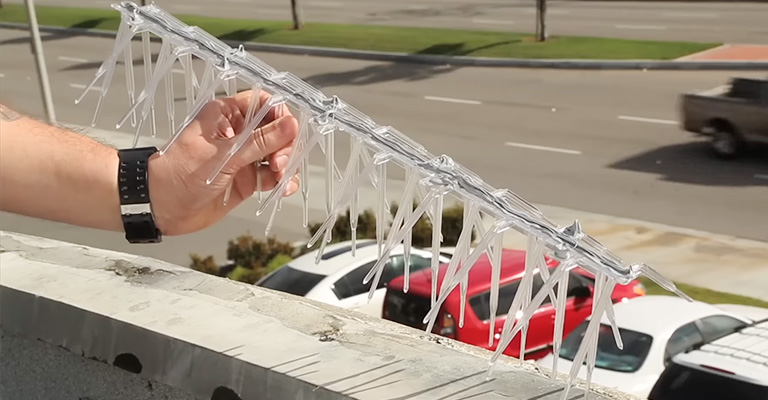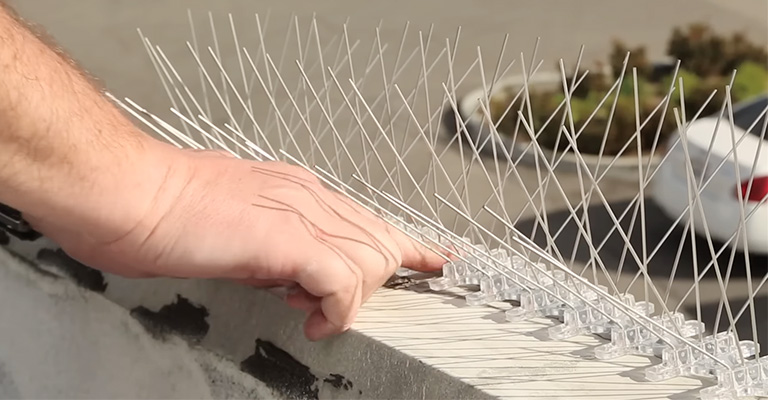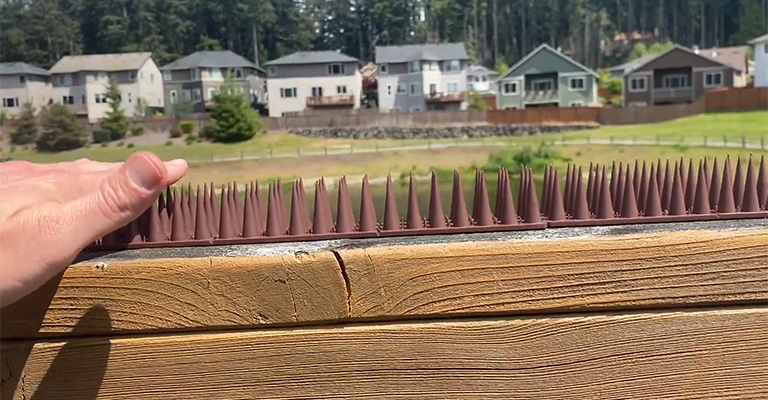Addressing bird-related problems, such as perching, roosting, or nesting in unwanted areas, often requires humane and effective solutions. Bird spikes, with their simple yet efficient design, offer a reliable means to deter birds from these areas.
Making your own bird spikes can be a cost-effective and environmentally friendly approach to protecting your property. By crafting your bird spikes, you can tailor their size, shape, and materials to suit your specific needs and surfaces.
This DIY approach not only saves on costs but also allows you to contribute to bird conservation by using humane and non-lethal methods.
In this guide, we will explore how to make bird spikes, enabling you to defend your property while ensuring the welfare of the birds.

How To Make Bird Spikes?
Bird spikes are a humane and effective solution to deter birds from perching or roosting on surfaces like ledges, rooftops, and signs. Making bird spikes at home can be a cost-effective and environmentally friendly way to address bird-related problems.
Here are simple methods for making DIY bird spikes:
Plastic Deterrent Spikes
To create plastic bird spikes, gather plastic strips or pipes and cut them into pieces of uniform length, usually 3-4 inches. Attach these pieces to the surface you want to protect, ensuring they are evenly spaced.
The pointed ends deter birds from landing, making it uncomfortable for them.
Wire Deterrent Spikes
Wire bird spikes are easily crafted using a strong, lightweight wire. Bend the wire into V-shapes or loops and secure them to the affected area. The sharp wire points prevent birds from landing while ensuring minimal harm.
Wooden Deterrent Spikes
For a natural look, wooden bird spikes are a suitable option. Cut wooden dowels or strips into small pieces, ensuring they have pointed ends. Attach these pieces to the surface, creating a wooden barrier that discourages birds from perching.
Nail Deterrent Spikes
Nails can be used to make simple DIY bird spikes. Hammer nails, leaving a portion exposed, into the area you want to protect. The exposed nailheads act as deterrents, making it uncomfortable for birds to land.
Duct Tape Deterrent Spikes
Duct tape can serve as a quick solution for bird spikes. Fold duct tape strips with the sticky side out, creating a barrier. Attach this barrier to the desired surface, making it challenging for birds to perch.
Bamboo Deterrent Spikes
Bamboo sticks can be cut into small lengths, ensuring they have pointed tips. Secure these bamboo pieces to the problem area, creating a natural and eco-friendly bird deterrent.
Straw Deterrent Spikes
Utilize straw or hay to craft homemade bird spikes. Bundle straw into small clumps and secure them to the affected surface. Birds find it uncomfortable to perch on the uneven surface of straw.
These DIY bird spikes are cost-effective, easily customizable, and humane methods to protect surfaces from bird-related issues.
When applying these homemade deterrents, be mindful of the local bird species and regulations to ensure you do not harm the birds or violate any laws protecting them.
What Type Of Bird Spikes Work Best?

Different types of bird spikes are designed to address specific bird-related problems and scenarios. Here are the types of bird spikes:
Plastic Bird Spikes
Plastic bird spikes are versatile and effective for a wide range of bird species. They work well on ledges, rooftops, signs, and other flat surfaces. The spikes are made of UV-resistant polycarbonate and can withstand various weather conditions.
Stainless Steel Bird Spikes
Stainless steel bird spikes are durable and long-lasting, making them ideal for commercial and industrial applications. They are resistant to corrosion and are often used in areas with heavy bird infestations, such as airports and warehouses.
Gutter Spikes
Gutter spikes are designed to keep birds out of gutters and downspouts. These spikes prevent birds from nesting or roosting in these areas, ensuring proper drainage and minimizing damage.
Roof Ridge Spikes
Roof ridge spikes are suitable for deterring birds from perching on the ridges of roofs. They are designed to blend with the roofline and offer effective protection against birds, ensuring the longevity of your roof.
Wide Plastic Bird Spikes
Wide plastic bird spikes are best for deterring larger bird species like pigeons and seagulls. These spikes have broader bases, making them suitable for covering wider surfaces, such as beams or signs.
Flex Track Bird Spikes
Flex track bird spikes are a flexible alternative that can be applied to curved or irregular surfaces. Their versatility makes them ideal for situations where standard rigid spikes may not be as effective.
Transparent Bird Spikes
Transparent bird spikes are designed to be inconspicuous and aesthetically pleasing. They work well on surfaces where appearance is a concern, as they are less visible from a distance.
The choice of bird spikes should be based on the specific bird species, the location, and the aesthetic requirements of the area you wish to protect.
Consider consulting with a professional pest control expert for the best advice on which type of bird spikes will work most effectively for your particular situation.
What Are Some Alternatives To Bird Spikes?

If bird spikes are not a suitable option for deterring birds, various alternatives are available, each with its own advantages and drawbacks. Here are the alternatives to bird spikes:
Bird Netting
Bird netting is a physical barrier that can be draped over areas to prevent birds from entering. It is especially effective for large outdoor spaces, gardens, or agricultural fields.
Bird netting allows light and air to pass through while keeping birds out.
Bird Repellent Gel
Bird-repellent gel is a non-toxic substance applied to surfaces like ledges, signs, and beams. Birds find the sticky gel unpleasant, discouraging them from landing. It’s suitable for areas where aesthetics are a concern, as it is nearly invisible.
Ultrasonic Bird Deterrents
Ultrasonic bird deterrents emit high-frequency sounds that are unpleasant to birds but mostly inaudible to humans. These devices can deter birds from specific areas and are particularly useful for large outdoor spaces.
Scare Devices
Scare devices like reflective tape, scarecrows, and balloons with predatory eyes can be effective for deterring birds temporarily. However, they may lose their effectiveness over time as birds become accustomed to them.
Electric Shock Systems
Electric shock systems deliver a mild, harmless electric shock to birds when they land on a protected surface. These systems are effective but are typically used in high-risk areas or when other methods have failed.
Bird Spiders
Bird spiders consist of a central hub with metal arms extending outward. These arms move in the wind, creating an unpredictable and intimidating obstacle for birds, preventing them from landing on surfaces.
Bird of Prey Decoys
Bird of prey decoys like owls or hawks can be placed in areas to mimic natural predators. Birds often avoid these areas, believing there is a threat nearby. However, they may become accustomed to the decoys over time.
The choice of an alternative to bird spikes depends on the specific situation, the bird species causing the issue, and any aesthetic considerations.
Consulting with a pest control professional can help you determine the most effective and humane method for addressing bird-related problems.
FAQs
What materials do I need to make DIY bird spikes?
To make DIY bird spikes, you’ll need materials like plastic or metal strips, adhesive or fasteners for securing the strips, and the necessary tools for cutting, shaping, and attaching the spikes.
Depending on your specific design, you may also require additional items like wooden dowels or bamboo sticks.
Are DIY bird spikes as effective as commercially available ones?
DIY bird spikes can be effective, but their success depends on proper design and installation. Commercially available bird spikes are designed for efficiency and durability.
If made correctly, DIY spikes can be equally effective and cost-efficient for deterring birds from unwanted areas.
Can I customize the size and shape of DIY bird spikes?
Yes, one advantage of making DIY bird spikes is the ability to customize the size, shape, and spacing according to your specific needs and the surface you want to protect.
This allows for a tailored solution that can effectively deter birds from your property.
Are DIY bird spikes humane and safe for birds?
DIY bird spikes can be humane and safe for birds when designed and installed properly. They provide a physical barrier to deter birds from landing, without causing them harm.
It’s essential to follow humane practices and local regulations when implementing bird spikes.
Do I need special skills to make DIY bird spikes?
While basic DIY skills are helpful, making bird spikes is generally straightforward. With the right materials, tools, and instructions, most people can create effective DIY bird spikes.
Online tutorials and guidance from experts can provide valuable assistance in crafting your own bird spike solutions.
Conclusion
The process of making bird spikes is a testament to the innovative and humane ways in which we can coexist with our avian counterparts.
By employing these simple yet effective DIY methods, you can deter birds from unwanted areas without causing them harm.
Crafting your bird spikes allows for customization, making them suitable for various surfaces and specific bird-related problems.
Whether you need to protect your property from pigeons, seagulls, or smaller bird species, making bird spikes provides an eco-friendly solution.
It also reflects a commitment to bird conservation, as you actively discourage birds from inhabiting unsuitable spaces while allowing them to thrive in their natural habitats.
Crafting bird spikes is a practical and ethical approach to addressing bird-related concerns while maintaining a harmonious balance with the avian world.